Me and my project partner are trying to create one stacked, horizontal barchart from multiple vertical barcharts as illustrated on the right hand side of the second picture. As of now, we were able to flip our graphs to a horizontal state with the help of this forum: Horizontal Barplot in ggplot2 . However, we are currently stuck at merging multiple horizontal bars into one.
We have currently been trying to implement ways to merge our bars into only one bar in our graphs (and to eventually merge all the graphs into a single one).
However, we could not find examples with datasets similar to ours, nor were we able to implement the posted answers/codes to our dataset/code.
This is our dataset simplfied thanks to an answer from this forum: How to make a great R reproducible example (with libraries included)
library(pdftools)
library(forcats)
library(stringr)
library(showtext)
library(ggplot2)
library(jpeg)
library(png)
library(gridExtra)
library(grid)
library(cowplot)
library(rgdal)
library(rgeos)
library(magick)
library(tidyverse)
ams <- structure(list(segment = c("Allgemein", "Allgemein", "Allgemein","Bundesland", "Bundesland", "Bundesland", "Bundesland", "Sektor","Sektor", "Sektor"),
group = structure(c(9L, 7L, 18L, 6L, 15L,20L, 21L, 8L, 11L, 17L), levels = c("25 bis 49", "Akad. Ausbildung","Ausländer_innen", "Bau", "Behinderung",
"Burgenland", "Frauen","Gastronomie", "Gesamt", "Gesundh. Einschr.", "Gesundheitswesen","Handel", "Höhere Ausbildung", "Inländer_innen",
"Kärnten","Lehrausbildung", "Leiharbeit", "Männer", "Mittlere Ausbildung","Niederösterreich", "Oberösterreich", "Ohne gesundh. Einschr.","Pflichtschule", "Salzburg", "Steiermark", "Tirol", "Über 49","Unter 25", "Verkehr", "Vorarlberg", "Warenherstellung", "Wien"), class = "factor"),
value = c(319232, 152957, 166275, 8247,18128, 44807, 35270, 42128, 10236, 26847),
abs_change = c(-17860,-10570, -7290, -544, -3944, -8778, -3329, -4019, 879, -5528),rel_change = c(-5.3, -6.5, -4.2, -6.2, -17.9, -16.4, -8.6,-8.7, 9.4, -17.1),
rel_change2 = c("-5,3%", "-6,5%", "-4,2%","-6,2%", "-17,9%", "-16,4%", "-8,6%", "-8,7%", "+9,4%", "-17,1%"),
abs_change_vj = c(-21910, -13342, -8568, -757, -1185,-5927, -2205, -471, -934, -4421), rel_change_vj = c(-6.4,-8, -4.9, -8.4, -6.1, -11.7, -5.9, -1.1, -8.4, -14.1),
rel_change2vj = c("-6,4%","-8%", "-4,9%", "-8,4%", "-6,1%", "-11,7%", "-5,9%", "-1,1%","-8,4%", "-14,1%"),
color = c("#CEDE8C", "#CEDE8C", "#CEDE8C","#CEDE8C", "#CEDE8C", "#CEDE8C", "#CEDE8C", "#CEDE8C", "#EE7F74","#CEDE8C"),
colorvj = c("#CEDE8C", "#CEDE8C", "#CEDE8C","#CEDE8C", "#CEDE8C", "#CEDE8C", "#CEDE8C", "#CEDE8C", "#CEDE8C","#CEDE8C"),
abs_change2 = c("-17.860", "-10.570", "-7.290","-544", "-3.944", "-8.778", "-3.329", "-4.019", "879", "-5.528"),
abs_change2vj = c("-21.910", "-13.342", "-8.568", "-757","-1.185", "-5.927", "-2.205", "-471", "-934", "-4.421")), row.names = c(1L,2L, 3L, 4L, 5L, 6L, 7L, 30L, 31L, 32L), class = "data.frame")
And here is an example of the code which produces one of our current bar graphs:
allgemein3 <-
ggplot(data = ams %>%
filter(segment == "Allgemein") %>%
# filters data that's not allgemein (general)
mutate(group = fct_relevel(group, "Männer", "Frauen", "Gesamt")),
# reorders sequence of "group" data in ams
aes(x = group, y = abs_change, fill = color)) +
# designates axis name and color
geom_bar(position = "stack", stat = "identity", width = 0.55) +
scale_fill_identity(guide = FALSE) +
geom_hline(yintercept = 0) +
coord_flip()
allgemein3
And this is the resulted bar graph: https://drive.google.com/file/d/1Uj_vWtuRtxiuIny6WT4_2s_V_07LGvaD/view?usp=sharing
And this illistrates the graphs in their original form (left hand side) and the graph which we desired (right hand side): https://drive.google.com/file/d/1P_2411HvTYB1OlXQCFbW_48_XzyHfILO/view?usp=share_link
This is our session info:
─ Session info ────────────────────────────────────────────────────────────────────────────────────────────
setting value
version R version 4.2.1 (2022-06-23)
os macOS Ventura 13.0
system x86_64, darwin17.0
ui RStudio
language (EN)
collate en_US.UTF-8
ctype en_US.UTF-8
tz Europe/Vienna
date 2022-11-10
rstudio 2021.09.2+382 Ghost Orchid (desktop)
pandoc 2.14.0.3 @ /Applications/RStudio.app/Contents/MacOS/pandoc/ (via rmarkdown)
Any solution or advice will be greatly appreciated! Please let us know any questions you have.

